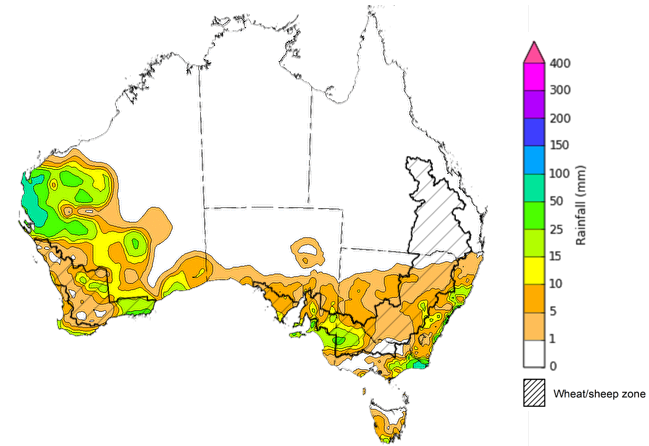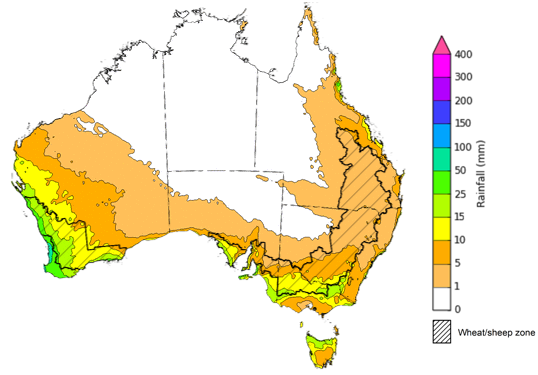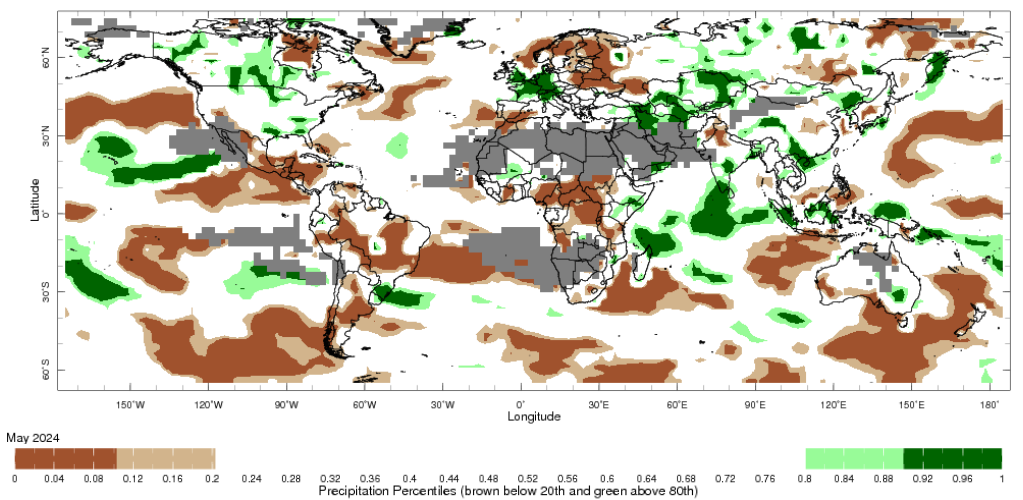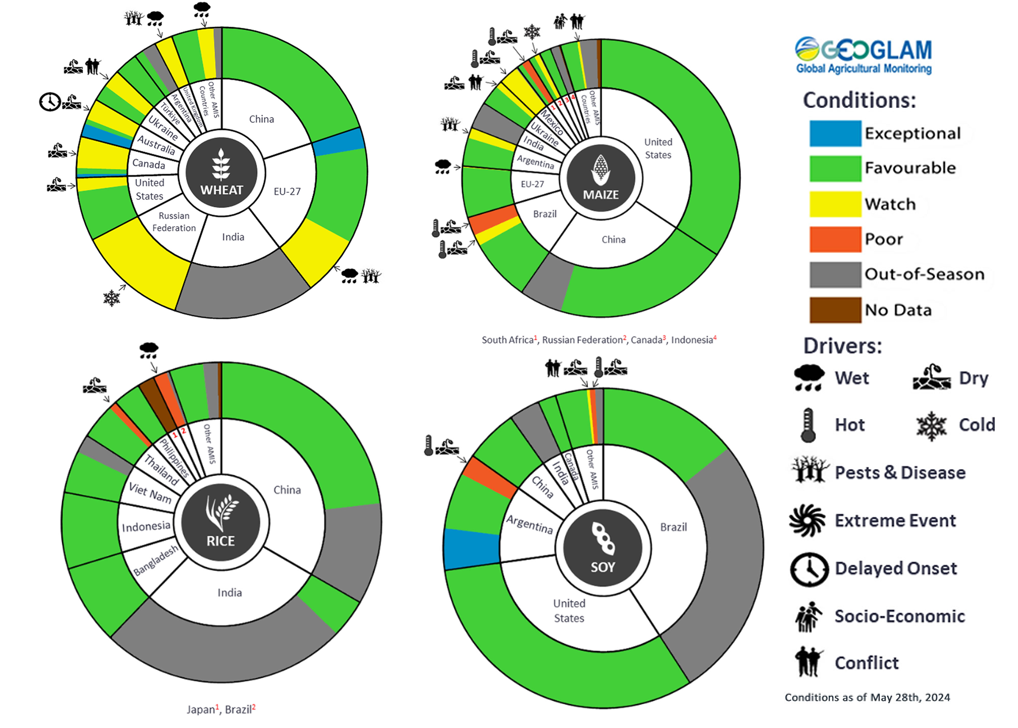Key issues
- In the week ending 19 June 2024, rainfall was isolated to the southern and western parts of the country.
- Across cropping regions, falls of between 5 and 50 millimetres were observed in South Australia, central New South Wales, eastern and southern Western Australia and western parts of Victoria. Remaining areas recorded little to no rainfall for the week ending 19 June 2024. Where received, this rainfall is expected to boost soil moisture levels, and allow for the germination and establishment of winter crops.
- Over coming days, little to no rainfall is forecast for central and northern parts of the country. A cold front is expected to bring rainfall totals of between 10 and 100 millimetres to much of south-western Western Australia. A low-pressure system over Southern Ocean is expected to bring rainfall of up to 25 millimetres across southern parts South Australia and New South Wales, Victoria and Tasmania.
- Across cropping regions, rainfall totals of up to 15 millimetres are expected in southern New South Wales. Falls of up to 50 millimetres are expected in Western Australia, and up to 25 millimetres across parts of South Australia and Victoria. If realised, this rainfall will support the germination and establishment of winter crops in these areas. Little to no rainfall is expected in the remaining cropping regions, with Queensland and northern New South Wales expected to remain generally dry.
- Globally, variable rainfall during May has led to mixed crop production prospects.
- Global production conditions were generally favourable for wheat, rice and maize but variable soybeans.
- Global production conditions have generally remained largely unchanged, except for in South America, compared to those used to formulate ABARES forecasts of global grain supplies and world prices for 2024–25 in its June 2024 edition of the Agricultural Commodities Report. As a result, global grain and oilseed production are likely to decline slightly compared to those presented in the June forecast, with increases in rice and maize production not sufficient to offset declines in wheat and oilseed production.
- Water storage levels in the Murray-Darling Basin (MDB) increased between 13 June 2024 and 20 June 2024 by 84 gigalitres (GL). Current volume of water held in storage is 17 223 GL, equivalent to 77% of total storage capacity. This is 17 percent or 3,472 GL less than at the same time last year. Water storage data is sourced from the BOM.
- Allocation prices in the Victorian Murray below the Barmah Choke increased from $20 on 13 June 2024 to $29 on 20 June 2024. Prices are lower in the Murrumbidgee due to the binding of the Murrumbidgee export limit.
Climate
- For the week ending 19 June 2024, rainfall was isolated to the southern and western parts of the country. Low-pressure troughs brought scattered fall ranging between 5 and 100 millimetres to areas of New South and eastern Victoria. Meanwhile, tropical moisture resulted in showers across western parts of Western Australia, with accumulation of up to 100 millimetres. A cold front brought up to 50 millimetres of rainfall to southern areas of Western Australia and South Australia, and western Victoria. This same cold front brought isolated falls of up to 25 millimetres to Tasmania. A high-pressure system kept central to northern Australia largely dry.
- Across cropping regions, falls of between 5 and 50 millimetres were observed in South Australia, central New South Wales, eastern and southern Western Australia and western parts of Victoria. Remaining areas recorded little to no rainfall for the week ending 19 June 2024. Where received, this rainfall is expected to boost soil moisture levels, and allow for the germination and establishment of winter crops.
Rainfall for the week ending 19 June 2024

Issued: 19/06/2024
Note: The rainfall analyses and associated maps utilise data contained in the Bureau of Meteorology climate database, the Australian Data Archive for Meteorology (ADAM). The analyses are initially produced automatically from real-time data with limited quality control. They are intended to provide a general overview of rainfall across Australia as quickly as possible after the observations are received. For further information go to http://www.bom.gov.au/climate/rainfall/
- Over the 8 days to 27 June 2024, little to no rainfall is forecast for central and northern parts of the country. A cold front is expected to bring rainfall totals of between 10 and 100 millimetres to much of south-western Western Australia. A low-pressure system over Southern Ocean is expected to bring rainfall of up to 25 millimetres across southern parts South Australia and New South Wales, Victoria and Tasmania.
- Across cropping regions, rainfall totals of up to 15 millimetres are expected in southern New South Wales. Falls of up to 50 millimetres are expected in Western Australia, and up to 25 millimetres across parts of South Australia and Victoria. Little to no rainfall is expected in the remaining cropping regions, with Queensland and northern New South Wales expected to remain generally dry.
Total forecast rainfall for the period 20 June to 27 June 2024

Issued 20/06/2024
Note: This rainfall forecast is produced from computer models. As the model outputs are not altered by weather forecasters, it is important to check local forecasts and warnings issued by the Bureau of Meteorology.
Crop production is affected by long-term trends in average rainfall and temperature, interannual climate variability, shocks during specific growth stages, and extreme weather events. Some crops are more tolerant than others to certain types of stresses, and at each growth stage, different types of stresses affect each crop species in different ways.
The precipitation anomalies and outlooks presented here give an indication of the current and future state of production conditions for the major grain and oilseed producing countries which are responsible for over 80% of global production. This is an important input to assessing the global grain supply outlook.
May precipitation percentiles and current production conditions
As of the end of May 2024, rainfall was variable for the world’s major grain- and oilseed-producing nations.
In the southern hemisphere, precipitation was below average across large parts of western and central Brazil, central Argentina, and much of southern Australia. Meanwhile, parts of southern Brazil and eastern Australia experienced above average rainfall. Rainfall was average in the remaining grain- and oilseed-producing regions in the southern hemisphere.
In the northern hemisphere, precipitation was generally below average in western parts of the Russian Federation, parts of northern India, south-western USA and Mexico. Precipitation was average to above average in parts of Canada, remaining areas of the US, the Black Sea Region, western Europe, the UK, southern India and most of China.
Global precipitation percentiles, May 2024

Note: The world precipitation percentiles indicate a ranking of precipitation for May, with the driest (0th percentile) being 0 on the scale and the wettest (100th percentile) being 1 on the scale. Percentiles are based on precipitation estimates from the NOAA Climate Prediction Center’s Climate Anomaly Monitoring System Outgoing Precipitation Index dataset. Precipitation estimates for May 2024 are compared with rainfall recorded for that period during the 1981 to 2010 base period.
Source: International Research Institute for Climate and Society
As of 28 May 2024, global production conditions were generally favourable for wheat, rice and maize but variable soybeans.
- Wheat: In the northern hemisphere, spring wheat sowing has concluded, with winter wheat harvesting set to start. In the southern hemisphere, sowing is underway for winter wheat.
- Maize: In the southern hemisphere, variable conditions in several major production countries has disrupted harvesting. In the northern hemisphere, sowing is progressing.
- Rice: Favourable conditions in parts of Asia are supporting crop development. In Southeast Asia, the transition between wet and dry season cropping is underway.
- Soybeans: In the southern hemisphere, harvesting in Brazil and Argentina is progressing following major flooding events. In the northern hemisphere, generally favourable conditions are supporting sowing.
Crop conditions, AMIS countries, 28 May 2024

Source: AMIS
The global climate outlook for July 2024 to September 2024 indicates that mixed rainfall conditions are expected for the world’s major grain-producing and oilseed-producing regions. Outlooks and potential production impacts for the major grain and oilseed producing countries are presented in the table.
| Region | June-August rainfall outlook | Potential impact on production |
|---|---|---|
| Argentina | Below average rainfall is more likely across much of Argentina. | Below average rainfall across most of Argentina is likely to negatively affect development and heading of wheat. However, it may allow uninterrupted planting of corn and cotton in September. |
| Black Sea Region | Generally, below average rainfall is expected in Türkiye and the south-west of the Russian Federation. Above average rainfall is expected in southern Ukraine. | Below average rainfall is likely to affect the critical development stages of spring wheat, cotton, corn, and sunflower in July. In Ukraine, above average rainfall is expected to support the growth of these crops. |
| Brazil | Below average rainfall is more likely across central and southern parts of Brazil. Above average rainfall in more like in northern Brazil. | Average to above average rainfall across northern Brazil may benefit wheat development over the period. However, below average rainfall in the south is likely to negatively affect the development of wheat but allow for uninterrupted planting of corn and cotton. |
| Canada | Generally, average rainfall is likely across much of Canada. Below average rainfall is likely in scattered areas in the southern regions. | Average rainfall is likely to support the flowering of wheat, canola, corn, soybean, and sunflower crops, and allow for the harvesting of spring wheat and canola in September. Average rainfall in isolated areas may benefit the development of crops in these locations. |
| China | Above average rainfall is more likely across much of central China, while below average rainfall is more likely in the southern and northern regions. | Average or better rainfall across much of China is likely to support the development and flowering of rice and corn. |
| Europe | Average rainfall is more likely for much of central Europe between July and September 2024. Below average rainfall is likely in the south. | Average rainfall across much of Europe is likely to benefit the development of corn, soybeans, and sunflower in the north. In the south, below average rainfall may negatively affect the flowering of sorghum. |
| South Asia (India) | Above average rainfall is more likely across much of India, while average to below average rainfall is more likely for isolated areas in the east. | Above average rainfall across much of India is likely to support the growth and development of corn, sorghum, rice, millet, groundnuts, cotton, and sunflower. |
| Southeast Asia (SEA) | Above average rainfall is likely across Indonesia and southern Malaysia. Average rainfall is likely in Thailand. | Rainfall across parts of Southeast Asia is likely to be sufficient to support the flowering of rice and corn which are to mature over the period to September. |
| The United States of America (US) | Generally, below average rainfall is likely for much of central and western US, with average rainfall more likely in the south and far east. | Below average rainfall across central west US may hinder the development of cotton, rice, corn, sorghum groundnuts, soybean, sunflower and millet, but permit the harvest of canola and spring wheat. |
Water
Water storages, water markets and water allocations - current week
The Tableau dashboard may not meet accessibility requirements. For information about the contents of these dashboards contact ABARES.
Commodities
Information on weekly price changes in agricultural commodities is now available at the Weekly commodity price update.
